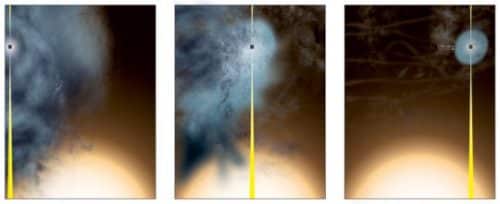A small galaxy loses almost all of its stars and gas during transit through a larger neighbor

Astronomers using the National Science Foundation's Very Large Array (VLBA) Very Sharp Radio Observatory have found the ragged remnants of a galaxy that passed through a larger galaxy, leaving only the smaller galaxy's nearly exposed supermassive black hole that exited the larger galaxy and is moving away from it at more than -3,200 km per second.
The galaxies are part of a cluster of galaxies that are more than two billion light years away from Earth. The close encounter, millions of years ago, stripped the small galaxy of nearly all its stars and gas. What remains is its black hole and a small galactic remnant that is only about 3,000 light years across. For comparison, our Milky Way is about 100,000 light years across.
The discovery was part of a program to discover very massive black holes, millions or billions of times more massive than the Sun, that are not found in the centers of galaxies. Supermassive black holes are at the center of most galaxies. Large galaxies are thought to grow by swallowing smaller galaxies. In such cases the black holes of both are expected to move in an orbit around each other and eventually merge.
"We are looking for pairs of very massive black holes moving in orbit, with one offset from the center of the galaxy, as evidence of a previous galaxy merger," said James Condon, of the National Radio Astronomy Observatory. "Instead, we found this black hole escaping the larger galaxy and leaving behind a trail of spillage," he added.
"We haven't seen anything like this before," Condon said.
The astronomers began the search by using the VLBA to create very high-resolution images of more than 1,200 galaxies previously identified through large-scale sky surveys made with infrared and radio telescopes. The VLBA observations they made showed that the supermassive black holes of almost all of these galaxies were at the centers of the galaxies. But one object, in a galaxy cluster called ZwCl 8193, didn't fit that pattern. Further studies have shown that this object, called B3 1715+425, is a very massive black hole surrounded by a much smaller and paler galaxy than we would expect. In addition, this object is rapidly moving away from the core of a much larger galaxy, leaving behind a trail of ionized gas.
The scientists concluded that B3 1715+425 is what's left of a galaxy that passed through the large galaxy and the encounter removed most of its stars and gas — a "nearly exposed" supermassive black hole. The runaway remnant, the scientists said, would likely lose more mass and stop forming new stars.
"For another billion years or so, it will be invisible," Condon said. This means, he noted, that there could be many more such objects left over from previous galactic encounters, which astronomers cannot discover." But the scientists will keep looking. They observe more objects, in a long-term project with VLBA. Since time is not critical in their project, Condon explained, they take advantage of "dead time" when the telescope is not in use for other observations.
"The quality of the data we receive from VLBA is very high. We get the location of the supermassive black holes very well. Our limiting factor is the accuracy of the location of the galaxy seen at other wavelengths that we use for comparison," Condon said. New optical telescopes coming on stream in the coming years, such as the Large Synoptic Survey Telescope (LSST), he said, will give them improved images that can be compared with the VLBA images. They hope this will allow them to discover more objects like B3 1714+425.
"And maybe also some of the binary very massive black holes we were looking for in the first place," he said.
More of the topic in Hayadan:

3 תגובות
Answer to Eran:
A black hole cannot be seen because no radiation can come out of it (hence the name black hole).
Radio waves are part of electromagnetic radiation, like light.
Why can't you see the image of the black hole and its remnants? Can you explain a little how it works to receive an image from radio waves? After all, it's not part of the spectrum of light or I'm wrong twice)
Apologies for the ignorance
Why can't you see the image of the black hole and its remnants? Can you explain a little how it works to receive an image from radio waves? After all, it's not part of the spectrum of light or I'm wrong twice)
Apologies for the ignorance